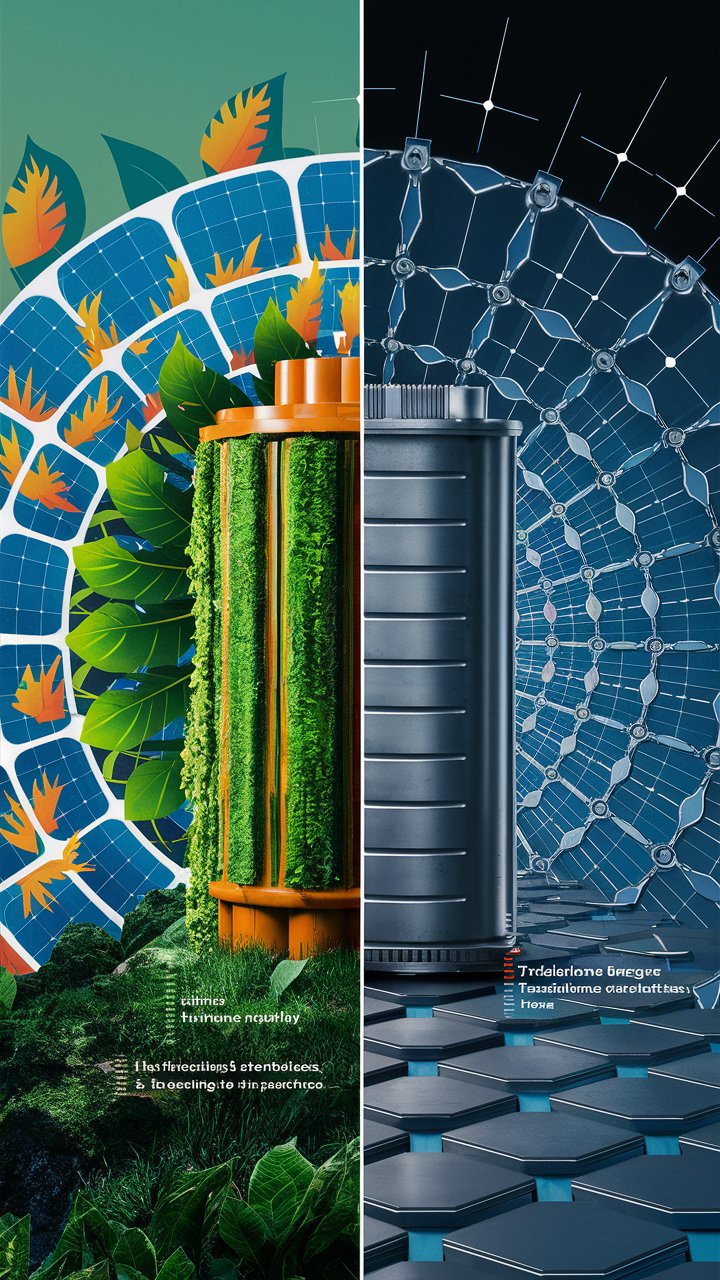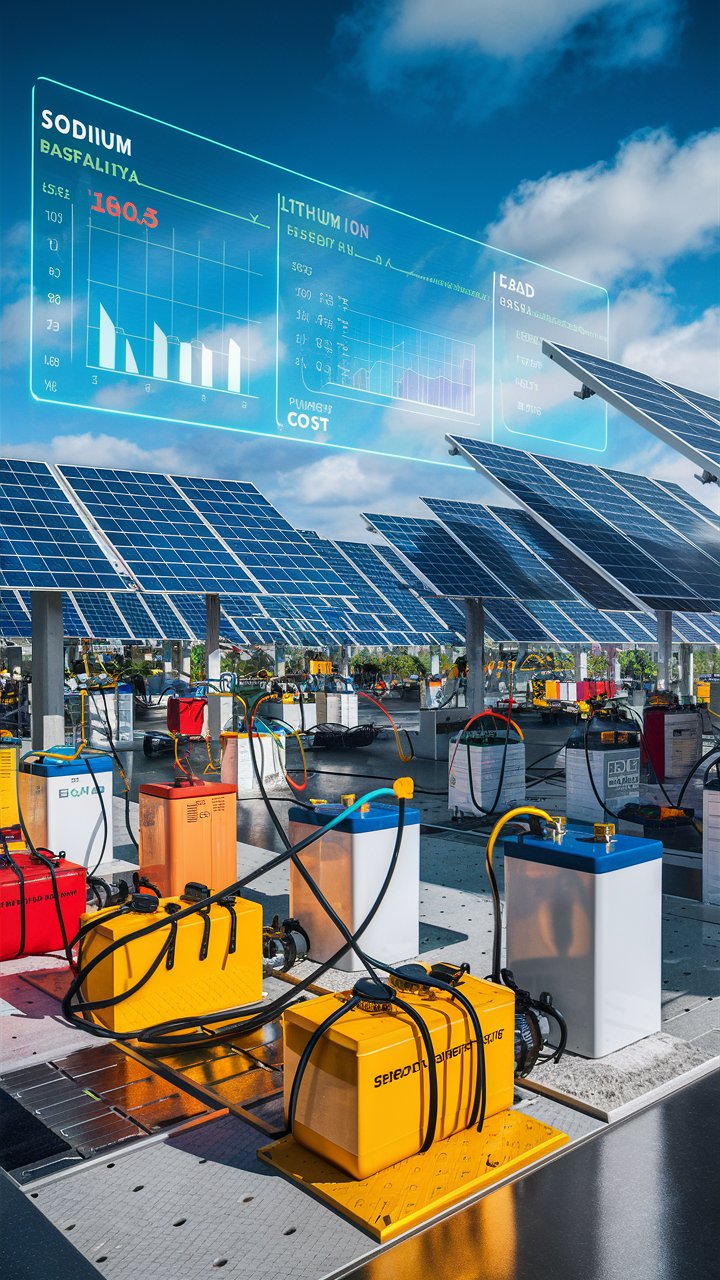Introduction
As the quest for sustainable energy solutions intensifies, sodium ion batteries emerge as a pivotal technology in the realm of solar energy storage. Distinct from traditional lithium batteries, these battery cells are shaping up to be batteries the next big thing due to their affordability and eco-friendly attributes. With advances in battery technology and production capabilities by battery manufacturers like CATL and Faradion, sodium ion batteries offer a promising alternative. These rechargeable batteries are not just safer than Li-ion batteries, they are also versatile enough to be used in various applications, from electric vehicles (EV) to home energy storage systems like the Tesla Powerwall, marking them as a commercially available choice for the future.
Sodium ion batteries leverage abundant materials to lower material costs and the need for expensive materials, making them a sustainable choice for large-scale energy storage. Unlike lead acid batteries and NMC batteries, sodium ion variants provide enhanced safety and energy efficiency, fitting perfectly into modern solar system installations. As the technology matures, these batteries could soon replace lithium-ion batteries, positioning themselves as a cornerstone of renewable energy integration.
Key Takeaways
- Sodium ion batteries offer significant advantages over lithium ion in solar storage due to their cost-efficiency, safety, and sustainability.
- The abundance of sodium compared to lithium makes sodium ion batteries a more scalable and sustainable option for energy storage systems.
- Breakthroughs in battery technology have positioned sodium-ion batteries as a cost-effective alternative for both commercial and residential solar applications.
- Sodium ion batteries have a long service life and maintain high energy capacity, making them ideal for long-term solar energy storage.
- These batteries facilitate the integration of solar power by providing reliable energy storage, capable of handling large energy demands during peak times or low sunlight conditions.
- Sodium-ion batteries are increasingly seen as the future of solar energy storage, aligning with the shift towards renewable energy sources.
Sodium Ion Batteries vs. Lithium Ion: Pioneering the Future of Solar Storage
Sodium ion batteries are gaining traction as a viable alternative to lithium ion batteries, especially in solar storage applications. Unlike lithium, sodium is abundant and offers a sustainable solution without the need for expensive, scarce materials. These batteries showcase competitive energy densities and enhanced safety profiles, being less prone to catching fire. Sodium ion technology aligns with the increasing demand for renewable energy solutions, providing a cost-effective and eco-friendly option for large-scale energy storage systems and electric vehicles.
Advantages of Sodium Ion Over Lithium for Solar Storage
Sodium ion batteries offer distinct advantages over lithium ion for solar storage, including better cost-efficiency and a safer chemical composition. These batteries are less prone to overheating and are more stable during charge cycles, making them ideal for sustainable home energy storage. The abundant availability of sodium also ensures a stable supply chain, crucial for scaling up solar infrastructure globally.
The Impact of Material Availability on Battery Choice
The availability of raw materials significantly impacts battery technology choices. Sodium, unlike lithium, is more abundant and widely available, which makes sodium ion batteries a more sustainable and scalable option for energy storage in solar power systems.
Unveiling Sodium-Ion Batteries: A Revolution in Battery Technology
Sodium-ion batteries represent a breakthrough in battery technology with their unique ability to offer high performance at lower costs. This technology utilizes sodium, an element far more abundant than lithium, which reduces material costs significantly. With the capacity to integrate seamlessly into existing solar energy storage systems, sodium-ion batteries offer a sustainable alternative, supporting the transition to renewable sources. They are particularly advantageous for home solar panel installations, promoting the widespread adoption of solar power.
Advantages of Sodium-Ion Batteries for Solar Storage
Here’s a concise list summarizing the potential advantages of sodium-ion batteries, especially in the context of solar energy storage, which could explain why they might be the next big thing in this sector:
1. Cost Effectiveness:
Sodium-ion batteries are expected to be less expensive than lithium-ion alternatives due to the abundance and low cost of sodium compared to lithium, which is becoming increasingly expensive due to high demand in various sectors.
2. Enhanced Safety Features:
These batteries are generally safer than lithium-ion batteries, with a lower risk of fire hazards because their electrolytes have a higher flashpoint. This safety feature makes them particularly suitable for large-scale energy storage applications.
3. Environmental Sustainability:
Sodium-ion batteries do not require cobalt or nickel, which are often associated with environmental and ethical concerns in their mining processes. This makes them a more environmentally friendly option.
4. High Energy Efficiency:
Despite having slightly lower energy densities than lithium-ion batteries, sodium-ion batteries have shown promising developments in achieving competitive energy storage capacities, with the potential to reach or exceed 200 Wh/kg in future iterations.
5. Broad Operating Temperature Range:
These batteries can operate effectively over a wider range of temperatures, making them adaptable for various environmental conditions, which is beneficial for solar storage systems that may experience diverse climatic conditions.
These points highlight why sodium-ion batteries are being considered a viable and potentially superior alternative for solar energy storage solutions. The ongoing research and development in enhancing their energy density and reducing costs further reinforce their potential to become more mainstream in the future.
Cost-Effective Production of Sodium-Ion Batteries
The production of sodium-ion batteries promises significant reductions in costs due to the use of abundant and cheaper materials. This cost-effectiveness facilitates more widespread use in commercial and residential solar systems, allowing for a broader adoption of solar energy.
Longevity and Performance of Sodium-Ion Batteries
Sodium-ion batteries not only provide a cost-effective solution but also offer longevity and robust performance. These batteries maintain excellent energy capacity over many charge cycles, making them suitable for long-term applications in solar energy storage.
Why Sodium Batteries are the Next Big Thing in Solar Energy Solutions
The shift towards sodium batteries in solar applications underscores their potential as the next big thing in energy storage. These batteries provide a robust solution for storing solar energy, thanks to their impressive cycle life and stability. Sodium batteries are an excellent choice for solar batteries due to their lower environmental impact and the ability to use less volatile and hazardous materials compared to traditional lithium-ion batteries. Their development is seen as a key step in advancing solar energy storage capabilities, making renewable energy more accessible and reliable.
Environmental Benefits of Sodium Batteries
Sodium batteries stand out for their minimal environmental impact. Unlike lithium-ion batteries, they use more sustainable materials and involve less risky chemical processes. This makes them an environmentally friendly choice for solar energy storage.
Integration of Sodium Batteries with Solar Panels
Integrating sodium batteries with solar panels provides efficient and reliable energy storage solutions. They are capable of storing large amounts of solar energy, which can be used during peak demand times or in low sunlight conditions, enhancing the effectiveness of solar power systems.
“Sodium-ion batteries are much better than lithium-ion batteries in terms of impact on mineral resource scarcity, and equivalent in terms of climate impact.” — Rickard Arvidsson, Associate Professor, Department of Technology Economics and Management, Chalmers University of Technology, Sweden (SciTechDaily).
Comparative Analysis: Sodium-Ion Batteries and Other Types of Solar Batteries
When comparing sodium-ion batteries to other types of solar batteries, such as lead-acid and lithium iron phosphate (LFP), sodium-ion stands out for its cost-effectiveness and lower environmental footprint. These batteries offer similar energy storage capabilities but are safer and more sustainable. They are particularly suitable for large-scale installations like solar farms and for homeowners looking to maximize their investment in solar systems. The comparison highlights the advantages of sodium-ion batteries, making them a preferred choice for future solar energy storage solutions.
Cost and Safety Comparison with Other Battery Technologies
Sodium-ion batteries are competitively priced and offer superior safety compared to traditional battery types like NMC and lead-acid. Their inherent stability and lower risk of thermal runaway make them a safer option for residential and commercial energy storage.
Suitability for Different Solar Energy Applications
Different solar energy applications require various battery characteristics. Sodium-ion batteries are versatile, making them suitable for everything from small residential systems to large solar farms. This adaptability is key to their growing popularity as a preferred energy storage solution.
Conclusion
In the evolving landscape of energy solutions, sodium ion batteries have clearly marked their territory as a new type of battery that could redefine how we store and use solar energy. As na-ion batteries continue to replace conventional lithium batteries, their role in battery storage systems becomes increasingly vital. They not only offer superior safety and cost-efficiency but also stand as a testament to sustainability, making them a preferred choice among several companies for both residential and commercial applications.
The future of sodium ion batteries looks promising, with ongoing advancements in battery production and demand expected to further boost their efficiency and storage capacity. As a cornerstone of solar energy storage solutions, they represent a significant shift towards more sustainable energy storage systems, backed by battery chemistries that prioritize environmental friendliness and resource availability. This transformative technology is setting a new benchmark for energy losses and operational safety in solar system installations, ushering in an era of more accessible and reliable renewable energy.












